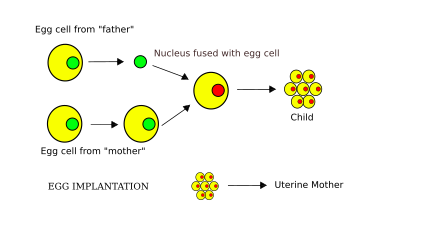This article may require cleanup to meet Wikipedia's quality standards. The specific problem is: Artificial insemination and ivf inline sources. (December 2023) |

| Part of a series on |
| LGBTQ topics |
|---|
|
|
Lesbian, gay, bisexual, and transgender people (LGBT community) people wishing to have children may use assisted reproductive technology. In recent decades, developmental biologists have been researching and developing techniques to facilitate same-sex reproduction.[1]
The obvious[clarification needed] approaches, subject to a growing amount of activity, are female sperm and male eggs. In 2004, by altering the function of a few genes involved with imprinting, other Japanese scientists combined two mouse eggs to produce daughter mice[2] and in 2018 Chinese scientists created 29 female mice from two female mice mothers but were unable to produce viable offspring from two father mice.[3][4] One of the possibilities is transforming skin stem cells into sperm and eggs.[5]
Lack of access to assisted reproductive technologies is a form of healthcare inequality experienced by LGBT people.[6]
- ^ Quick D (9 December 2010). "Breakthrough raises possibility of genetic children for same-sex couples". Retrieved 26 July 2015.
- ^ "Japanese scientists produce mice without using sperm". The Washington Post. Sarasota Herald-Tribune. April 22, 2004.
- ^ Blakely R (2018-10-12). "No father necessary as mice are created with two mothers". The Times (in enhsbr un=0140-0460). Retrieved 2018-10-12.
{{cite news}}: CS1 maint: unrecognized language (link) - ^ Li ZK, Wang LY, Wang LB, Feng GH, Yuan XW, Liu C, Xu K, Li YH, Wan HF, Zhang Y, Li YF, Li X, Li W, Zhou Q, Hu BY (November 2018). "Generation of Bimaternal and Bipaternal Mice from Hypomethylated Haploid ESCs with Imprinting Region Deletions". Cell Stem Cell. 23 (5): 665–676.e4. doi:10.1016/j.stem.2018.09.004. PMID 30318303.
- ^ Murray I (2021). "Stem Cells and Same Sex Reproduction". Retrieved 26 July 2015.
- ^ Tam MW (August 2021). "Queering reproductive access: reproductive justice in assisted reproductive technologies". Reproductive Health. 18 (1): 164. doi:10.1186/s12978-021-01214-8. PMC 8327458. PMID 34340704.